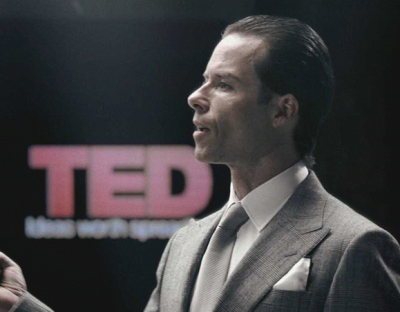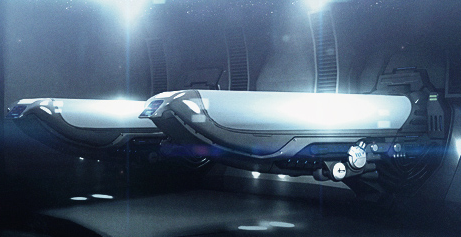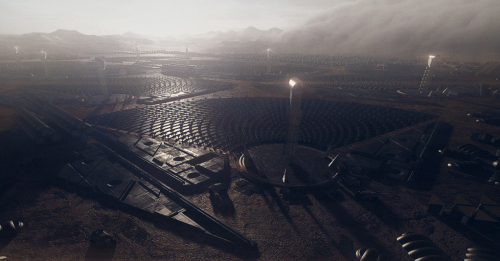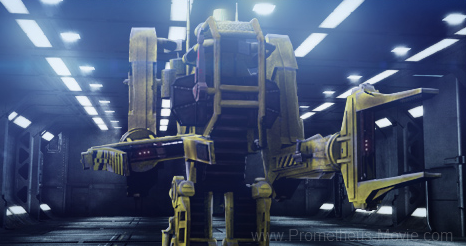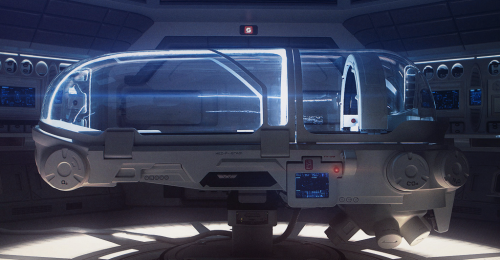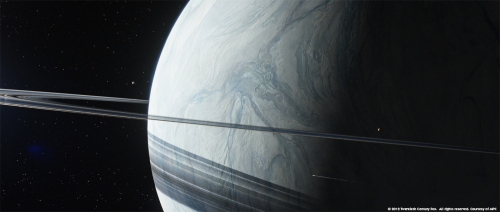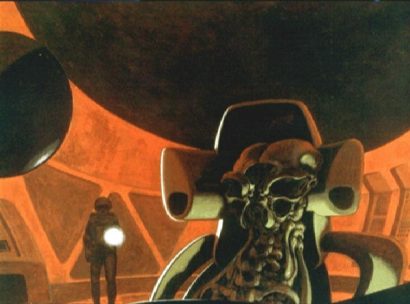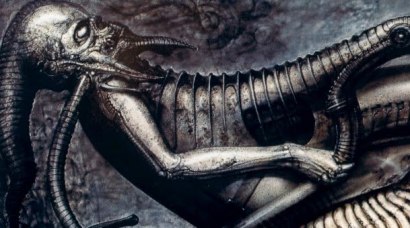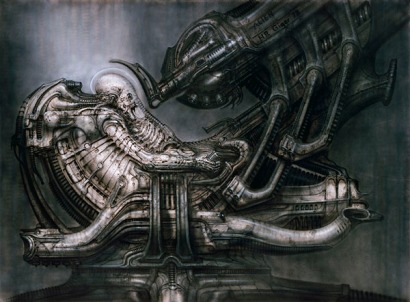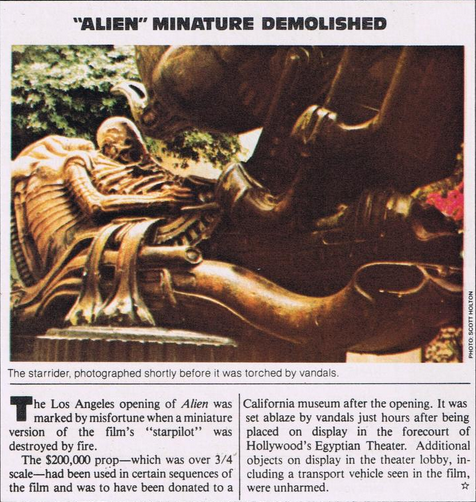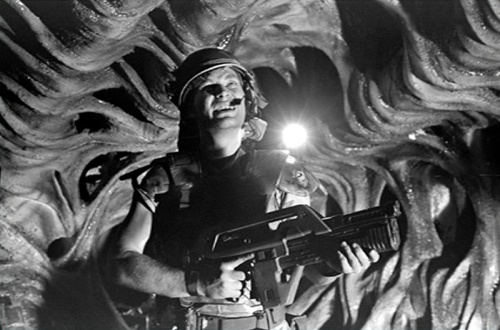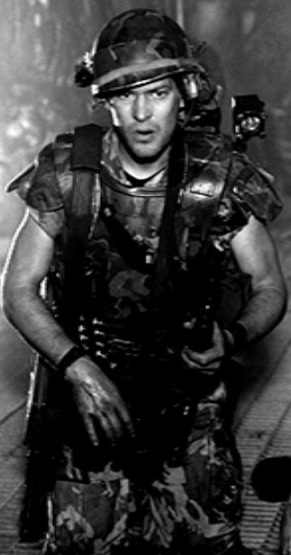
“Now that Joss Whedon has turned in his script to the Fox Big Brass and awaits their approval, how much longer do we have to wait for the next Alien sequel? We wish we knew.”
~ Cinescape magazine, 1995.
Fifteen years lapsed between Alien Resurrection and the next Alien-verse follow-up, Prometheus. As with any of the films post-Aliens, Twentieth Century Fox sought to capitalise and make a sequel immediately; it was merely a matter of which direction the series ought to take—and the series looked in many directions, from a continuation of Alien Resurrection, to the Alien vs. Predator offshoots and rumours of an Alien remake, before finally settling on a prequel. “It’s the story of creation,” said Ridley Scott, “of the gods, and the man who stood against them …”
In 2007, when asked how he would like to see the series continue, Alien creator Dan O’Bannon was decisive: “I’d like to see it stop.” Tired of endless sequels that would continue to “drain any remaining impact out of the original”, O’Bannon opined that the series had been “played out after the first [sequel]. Cameron, in the first one, did about the only thing that you could do, which was that he switched to a different genre … But once he had done that, there was really nothing left to do. And they just keep squeezing the thing until it’s an empty bag.”
Even series producer Walter Hill referred to Alien 3 as “another complete fucking mess,” and went on to explain, “The studio wanted to crank out another one … David [Giler] and I were a bit sick of it, and wanted to end the whole thing … Fifteen years later, and we’re still in hotel rooms rewriting Alien … We had nothing to do [with Alien Resurrection], didn’t even think it was a good idea for starters, we thought we had ended the series … Personally, I think it’s a lousy movie.”
“With Sigourney Weaver in the lead and James Cameron behind the camera, Alien 4 looks set to restore the genre’s finest fear franchise – with more than a little help from twenty-something screenwriter Joss Whedon. Fresh from polishing the script of Kevin Costner’s mega-budgeted fantasy movie, Waterworld, Whedon resurrects Ripley with the time-honoured sci-fi premise of cloning, and that’s not the only twist he has in store. He says, ‘Is she all woman or is just a little something wrong? The whole intention is that when she comes back from the dead, she has to be larger than life.’
Whedon cites the original Alien as the film that’s had more influence on him than any other and promises that Alien 4 will be extraordinary – ‘I want to do an Evil Dead, where it’s really menacing and never stops. I want every scene to contain something special.'”
~ Starburst magazine, 1995.
Back in 1997, whilst promoting the aforementioned movie, Twentieth Century Fox were confident in the validity of the franchise: “All we can say is that the end of Alien Resurrection points you towards the locale of Alien 5,” Tom Rothman told Entertainment Weekly. Rothman was confident that the Alien sequel train would continue rolling unabated in the wake of Resurrection, which was expected to revitalise the series after the dour turn and critical lashing of Alien 3: “We firmly expect to do another one: Joss Whedon will write it, and we expect to have Sigourney and Winona if they’re up for it.” Whedon himself teased, “There’s a big story to tell in another sequel. The fourth film is really a prologue to a movie set on Earth. Imagine all the things that can happen.”
Alien 5 seemed planned even before Alien Resurrection was shown to audiences. In March 1996 Weaver said, “I am absolutely sure there will be an Alien 5 , because I know how Alien 4 ends. I am the last person who thought I would do another one, but we have a wonderful script. They came up with the most the most provocative situation for Ripley to find herself in. It is very unexpected and will surprise a lot of people and will give me an interesting job.”
Later the next year, Whedon outlined to SFX magazine his plan for approaching Alien 5: “If I write this movie, and it has my writing credits on it, then it’s going to be on Earth … And it’s going to be very different from the last one … The studio talked about Alien Resurrection as a kind of placeholder. They said, ‘We want to do Earth or the big Alien planet, but we’re not convinced yet that this franchise has legs. So we want to do a smaller story.’ I don’t think you can do that with Alien 5. I think the time of people running around in a tin can has passed. You have to work on a broader canvas otherwise it becomes an episode and not a new movie. The way Cameron exploded from the first to the second, you have to do that again, and that means going somewhere new … With Alien Resurrection, I used the first two movies as models, but with this one I can promise you something new, something completely different from what’s been seen before.”
The two prominent ideas for Alien 5 were Aliens-on-Earth, and planet-of-the-Aliens. Aliens running amok on Earth had in fact been advertised as the plot for Alien 3, though no script for such a film ever existed. A trailer proclaiming that, “On Earth everyone can hear you scream,” came and went. Despite anyone’s enthusiasm for an Earth-bound Alien film, Weaver herself claimed no interest in the idea: “The only thing I’m not interested in is going to Earth. I saw that Star Trek movie where they went to Earth and … yawn. I think it’s more fun to go to a foreign planet … Fantasy is what we need!”
Ridley Scott also found the idea of Aliens on Earth to be less enticing than exploring the origin of the creatures: “Earth would be interesting, and there is talk about it … I say we should go back to where the Alien creatures were first found and explain how they were created. No one has ever explained why. I always figured that a battleship carrying bio-mechanical organisms that could be weapons was sent into space with some Space Jockey who didn’t last long.” He elaborated on his vision of Alien 5 further: “I had an idea for a fifth installment in the series. It would be all about the Aliens themselves: what their world and civilization are like. What made them tick. We always thought of that derelict spacecraft, where they found all the eggs in the first one, as a sort of aircraft carrier or bomber. They would drop the eggs on the planets they wanted to conquer, then come back a few years later after the landscape had been ‘cleared,’ so to speak.”
Ridley’s idea about exploring the culture which originated the Aliens was a persistent one. Alien‘s associate producer, and friend to Scott, Ivor Powell, claimed to be fascinated by the same theme: “I would have gone before [Alien], that’s what I find interesting. I want to know who that Space Jockey is. What are the Aliens doing in the silo? Are they armaments, are they shipping them somewhere?” Journalist Paul Sammon, author of Future Noir: The Making of Blade Runner, expressed interest in the same idea, pointing to the untapped lore lying behind the original film: “Despite the fact that there have been four films in the saga so far, there are still all these unanswered questions that the original brought up. Like, what’s the deal with LV-426? Where did the original Alien race come from? Who are they, really? What are they? Who was the Space Jockey? Why did it have all those eggs on a crashed ship? I mean, the first Alien hinted at a whole backstory that hasn’t been explored in the saga yet.”
Despite the intense curiosity in such themes and storylines, Fox was still touting Joss Whedon as the pen behind their planned Alien 5, with Vincenzo Vitali, the director of Cube, briefly rumoured to be aiming for the director’s chair by the Spanish press.
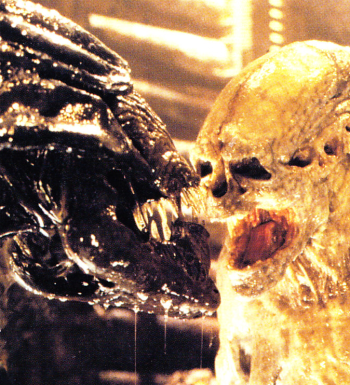
“I remember a young writer friend called me when I was in LA, and he called me from London after the fourth [film] one and said, ‘I’m crying.’ I asked why and he said, ‘I’ve just come out of Alien [Resurrection], and they’ve turned it into a comedy!’ He said, ‘The world of Alien is just going to collapse – this is the end of it.’ And it’s true – you don’t hire a comedy director to make Alien.”
~ Roger Christian, Alien art director, 2010.
However, a frustrated Whedon seemed to have lost interest in a fifth movie after
Resurrection‘s release, stating: “I’ll tell you there was a time when I would have been interested in that, but I am not interested in making somebody else’s franchise anymore. Any movie I make will be created by me.” When later asked by a fan at the 1998 San Diego Comic Con about any potential
Alien 5 involvement, Whedon replied: “Uhh, that’s a big no. Did you see
Alien 4?” Without a writer, the latest proposed sequel seemed stuck, but two series regulars were, briefly, working on a collaborative effort to bring
Alien 5 back from development hell.
“Ridley and I talked about doing another Alien film,” James Cameron told AICN in 2006, “and I told Fox that I would develop a fifth Alien film.” Cameron had told the BBC in 2003: “We’re looking at doing another one. Something similar to what we did with Aliens: a bunch of great characters and, of course, Sigourney.” Cameron name-checked Arnold Schwarzenegger as one casting possibility (which would never come to pass regardless of the project’s completion, considering Arnold’s impending governership,) and even Harrison Ford was rumoured. Also in 2003, Cameron spoke to the Houston Chronicle about how Alien 5 should also draw on the uncompromising nature of Ridley’s original movie: “[Alien] holds a special classic niche as one of the great terrifying experiences, and the trick [to making a new Alien film] is you don’t go crazy and make a $150-million movie, because you don’t want to have to compromise, you don’t want to try to do a PG-13 Alien that is all things to everyone. It’s got to still maintain its roots in this kind of cinematic Id. Ridley did it really beautifully. He just kind of put you into this Freudian nightmare in space.”
Though Scott’s interest in returning to the series was lackadaisical even with Cameron working on a script, any co-Cameron/Scott Alien 5 project was eventually put out of order by Fox, who decided to bring the Alien vs. Predator series to the big screen instead. “I was working with another writer,” Cameron explained, “and Fox came back to me and said, ‘We’ve got this really good script for Alien vs. Predator …'”
“Ridley and I talked over lunch maybe 10 years ago and I said, ‘Look, I’ll write it and produce it, you direct it, it’ll fucking kick ass!’ And he was like, ‘Yeah, let’s do it!’ And nothing happened. And then they did Alien vs. Predator, and that kind of pissed in the soup.”
~ James Cameron, Total Film, 2009.
Fox had toiled with bringing the comic book venture to the screen for almost a decade, but it was a pitch by writer/director Paul W.S. Anderson (and an alleged truce of sorts between Alien and Predator‘s producers) that allowed the project to finally go green. Anderson had toyed with Alien-style horror (with a dash of Hellraiser and Solaris) in his 1997 film, Event Horizon. “If you’re going to make a horror movie, it doesn’t get any better than Alien,” he has said. “I’ve been waiting to do a movie with Aliens in it since I was at school, since the first Alien movie came out, since I fell in love with Sigourney Weaver and since the Alien scared the hell out of me.” However, Anderson admitted to Empire magazine that his Alien vs Predator film was not designed to mimic either Alien, Aliens, nor even Predator: “Hopefully it’s got elements of both, but it’s built to please a younger audience exposed to the video games and comic books.”

“Alien vs. Predator has had a torturous history,” Anderson told Empire magazine. “Fox have had a script for it for ten years, ever since Peter Briggs did an adaption of the comic book, and yet they didn’t make it. Alien was still an active franchise and the producers not seeing eye-to-eye was a stumbling block for a long time. I think a lot of them don’t actually get on. But by the time I was involved there was a sense at the studio that they were dead franchises.”
“AVP presents possibilities to re-energise both franchises,” Anderson continued. “I set about making a standalone movie that didn’t contradict anything within the original franchises, but fed into them, and then left other filmmakers to go and make an Alien 5 or Predator 3.” He finished by joking, “This is AVP, and whoever wins, Rupert Murdoch wins!”
Ultimatley, Anderson’s movie didn’t do much to instill confidence in the series on behalf of either critics or long-time fans, (fan-site AVPGalaxy temporarily closed down in response, and when asked for his opinion on the movie, Dan O’Bannon quipped: “videogame.”) Still, the AVP installments continued with Aliens vs. Predator: Requiem, written by a co-writer of the first movie, Shane Salerno, and directed by first-time helmers, Greg and Colin Strause; two special effects artists who founded VFX company, Hydraulx. After the tribulations of Alien 3, Resurrection, and Anderson’s Alien vs. Predator, Requiem did what seemed to be impossible – and brought the Alien brand to its nadir.
A requiem is defined as “a Mass for the repose of the souls of the dead,” and if the second AVP film demonstrated anything, it was that the reputation of both Alien and Predator franchises were firmly in the ground. Even though it was released in January of 2007, Empire magazine was quick to dub the film a “strong contender for worst film of the year.”
Failing to predict the reaction towards their movie, the Strauses had originally intended for their film to lead in to another Strause-helmed AVP. The brothers told i09: “The original ending for AVPR, that we pitched them, ended up on the Alien homeworld, and actually going from the Predator gun, that you see at the end, it was going to transition from that gun to a logo of a Weyland-Yutani spaceship that was heading to an Alien planet. And then we were actually going to cut down to the surface [of the Alien planet] and you were going to see a hunt going on. It was going to be a whole tribe of Predators going against this creature that we called King Alien. It’s this huge giant winged Alien thing. And that was going to be the lead-in, to show that the fact that the Predator gun [at the end of AVPR] is the impetus of all the technological advancements that allowed humans to travel in space. Which leads up to the Alien timeline.”

Colin Strause told i09: “[Humanity] could take that and reverse engineer [Predator technology], figure out what the power source was – all of those things. And in theory, that would enable that company [Weyland-Yutani] to make massive advancements in technology and dominate the space industry. That was the whole idea, to literally continue from Ms. Yutani getting the gun, and then cut to 50 years in the future, and there’s spaceships now. We’ve made a quantum leap in space travel. That was going to set up the ending, which would then set up what AVP3 was going to be, which would take place 100 years in the future. That was kind of the plan.”
In an interview with a UK newspaper, Colin announced: “The next film I want to do would be back on the Alien homeworld. And I’d like to introduce the viewers to Aliens so big, they’re almost dinosaur size, or even bigger, with more of a space theme.”
Fan response was understandably negative. “People who hate the movie will say any idea of ours is dumb, regardless of its merits,” Colin Strause said in response to criticism of the planned AVP3, over at AVPGalaxy forums. “I bet if some other director said the same thing most of you [the fanbase] will be saying it was the best idea ever; of course you will never admit that.”
Ultimately, after the abysmal Aliens vs Predator: Requiem and the overwhelming negativity directed at the film and its directors, even Fox lost its taste for bringing the two creatures together again, and AVP was shelved.
There were rumours of an Alien remake doing the rounds shortly thereafter, though Alien 5 was briefly on some people’s lips, with even Tom Woodruff Jnr of Amalgamated Dynamics wanting to have a shot at the film: “I would love to work on an Alien film and totally … not so much re-invent the Alien, but devise a new Alien that’s of that same world, but is still different. We had little stabs at it, like with the Newborn creature in Alien Resurrection.” Alec Gillis also mentioned Woodruff’s interest in Alien 5, though he kept tight-lipped on details: “I can’t really speak to that concept for an Alien 5, because it’s still something that’s pending.”
Finally, during a press junket for The Taking of Pelham 123 in 2009, Tony Scott, brother to Ridley, revealed: “Carl Rinsch is going to do the prequel to Alien.” The other Scott brother was pleased that Rinsch, a son-in-law to Ridley, was helming: “I’m excited ’cause Ridley created the original and Rinsch is one of the family.” Rinsch’s tenure on the prequel didn’t last long however. Later in 2009, it was announced that Ridley Scott himself would return to the Alien series and direct the prequel to his 1979 classic.
Scott had mused on returning to Alien since the early eighties. Another film, according to Scott, “certainly should explain what the Alien is and where it comes from. That will be tough because it will require dealing with other planets, worlds, civilisations. Because obviously the Alien did come from some sort of civilisation … The Alien may be one of the last descendants of some long-lost self-destructed group of beings … What I missed most of all [in the first film] was the absence of a prognosis scene. There were no speculative scenes or discussions about what the Alien was and all that sort of thing either. I believe that audiences love those, especially if they’re well done. They give the threat much more weight. If they make Alien II, and if I have anything to do with it, the film will certainly have those elements in it. From a certain point of view, Alien II could be more interesting than Alien I.”
Of course, as history went, James Cameron was the first to bring a sequel to the screen. Scott, on the other hand, was left out entirely. “I was a little dismayed,” he said, “no one even mentioned it to me.” However, Scott relieved himself knowing that “Jim loved Alien, adored it … I would never, ever critique or criticise [Aliens] because I think it was very successful and what he did was really good.” In fact, whilst Cameron was directing the sequel at Shepperton Studios, he bumped into Ridley himself. “I was coming out of dailies,” Cameron told Fangoria in 1986, “and he was going in, and we spoke for about ten minutes. We didn’t really talk about Aliens at all; he didn’t seem particularly curious about it, other than the fact it was being done. We just spoke in general terms about shooting in England. It was very polite, there was no depth to it. Basically, it was like, ‘Hello, pleased to meet you.'”
Scott was also considered for Alien 3, but could not clear his schedule. “He could never get it together,” claimed Sigourney Weaver. However, he did find time to drop in on David Fincher during filming, and was even interviewed on the set. “This is not the way to make movies,” he told the struggling Fincher, “make sure you make a little film where you have some control whilst they’re beating you up.” Two decades later, Scott would return to Shepperton to again stand on an Alien-verse set.
“From the very early going all the scripts said Untitled Alien Prequel, and then we tried a bunch of colons, it was Alien: Engineers, Alien: Genesis, Alien: Origins.”
Jon Spaihts, Prometheus enhancement pods, 2012.
“It’s a brand new box of tricks,” Ridley told Empire in 2009 on the subject of the prequel. “We know what the road map is, and the screenplay is now being put on paper. The prequel will be a while ago. It’s very difficult to put a year on Alien, but if Alien was towards the end of this century, then the prequel story will take place thirty years prior … I never thought I’d look forward to a sequel, but a prequel is kind of interesting. I’m looking forward to doing that.” That same year, when talking to MTV, Scott said: “I’ve got a pile of pages next to me. It’s like the fourth draft. It’s a work in progress, but we’re not dreaming it up anymore. We know what the story is. We’re now actually trying to improve the three acts and make the characters better, build it up to something. It’s a work in progress, but we’re actually making the film.”

“I’m in Pinewood now doodling spaceships,” said the Alien prequel’s production designer, Arthur Max, in 2010. “I’ve got a little art department and we’re trying to get it off the ground … we can deconstruct the original. That’s an interesting challenge to anticipate. Where it all came from. Its origins. It’s almost like archaeology. You’re designing in reverse time.”
Though there was no chance of Ripley appearing in a pre-Ripley world, Sigourney Weaver was happy to see the series returning to Ridley: “I’m glad it’s in his hands. I always said if you’re going to do another one, go back to the planet where they came from, so I certainly think it’s a great idea. I’ll be excited to see it. I think he’s an amazing director and I always felt very incomplete because we didn’t know where they came from, and so we’re going to find out I hope.” James Cameron was likewise excited: “I cannot wait to see it. I truly cannot wait. I will be the first person in line to see it – but he’d [Ridley] better invite me to a preview screening!”
Scott also made it clear that if the Alien creature was to return, then it wouldn’t assume the recognisable shape of the creatures from the previous movies. “They’ve squeezed the franchise dry,” said Ridley. “The first one will always be the most frightening, because the beast we put together with Giger and all its parts -the facehugger, the chestburster, the egg- they were all totally original, and that’s hard to follow … I don’t want to repeat it. The Alien in a sense, as a shape, is worn out. Once I get more serious and get going, and the big wheels start turning, we’ll [Scott and Giger] certainly talk. And maybe we’ll come up with something completely different.”
“In my view, the story of Alien can only go one direction; to return home to the planet where the first discoveries were made, which might be an opportunity to provide fans and audiences with past surprises and answers to questions they had. I am convinced that everyone who was involved from the beginning of the production of this series has the same feelings as me.”
~ HR Giger, Tatuaz magazine, 2008.
Excitingly, Giger seemed to confirm his involvement in the film to a Swiss newspaper in February 2011, saying: “Ridley Scott and I met in London to discuss the details of the project. It was a warm reunion after such a long time. It’s going to be huge. I can not tell you what I’m doing exactly.”
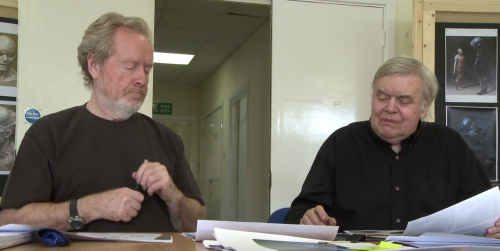
Ridley and Giger rifling through Prometheus designs and sketches during production.
People had returned from one Alien movie to another before, including Alien–Aliens conceptual artist Ron Cobb; Alien focus puller-turned Aliens cinematographer Adrian Biddle; Alien Queen stuntmen-turned-Fiorina 161 prisoner stuntmen Nick Gillard and Malcolm Weaver; and Alien–Aliens creature stuntman, Eddie Powell. However, none were as monumental or even as instrumental as Scott and Giger, and fans as well as the media waited in anticipation for further news.
It was in this hush period that the embryonic film underwent massive changes. The most significant of these was the recruitment of a secondary writer (Damon Lindelof, hired to buttress a script originally by Jon Spaihts) and the new movie’s subsequent and very deliberate distancing from Alien; though the new film, tentatively titled Paradise before becoming Prometheus, would still retain an umbilicus to the original series.
“We were told several different titles, we didn’t really know what the project was called. My paperwork said Alien Prequel, Untitled Alien Prequel. That’s what I was working on. Then LV-426 was the title, so some people say ‘oh it’s not the same planet,’ but in Ridley’s mind it could have been at one point … And then another title was Paradise … and then one day, boom, Prometheus.”
Steven Messing, Visual Effects Art Director, Prometheus enhancement pods, 2012.
In 2012, Spaihts explained: “If you’ve seen the original Alien, you’ve seen the remains of the enigmatic giant—whom the fan community calls the “Space Jockey”—who has died in the derelict wreck. This character is the great, unopened door of that original film—the great mystery. Who is that? Where did that derelict ship come from? How did that giant die? And it’s in that mystery that the story seed of Prometheus takes root. There is some inevitable kinship between the two stories [Alien and Prometheus] in terms of xenobiology. But the titular creature of Alien is very much confined to the shadows and is not at all the focus of Prometheus, which is driving in a new direction. With Prometheus, the origin of the menace and forces that our heroes encounter is essentially the central mystery of the tale itself. So the story is very much about people prying into the shadows and trying to shed light on these mysteries.”
Like Resurrection and Alien vs. Predator before it, Prometheus was also intended to bring a new life to the tired series. “From the get-go,” said Spaihts, “the studio made it plain that they were interested in not just a new film but a new limb for a new franchise altogether. My story development envisioned a trilogy from the beginning.” Spaihts elaborated further with EMPIRE magazine: “I did have a plan for multiple films and the conversations I had with Ridley was about a new franchise from the beginning. We talked about a possible trilogy, or a duology, but more often as a trilogy. And I did have pretty broad notions as to how we were going to get from this world to the original Alien – the baton pass, closing the circle, if you will.”
Jon Spaihts on the Prometheus writing process: “At the time I was brought aboard, Ridley was looking to return to the Alien universe. They were calling it a prequel at the time, and Ridley was going to produce and not direct. I took a stab at the story and came up with something they really liked, and Ridley got so excited he decided to direct it himself. It really threw everything into overdrive at the studio … I worked with Ridley to create five drafts of the script, then 20th Century Fox wanted a more established writer to finish the project, which is typical of studios, and so Damon Lindelof was brought on board and he worked with Ridley on the final draft … I created a mythology that was outside of the original film, and became the centre of the movie. It remained the centre as Damon took over and took the work forward.”
Damon Lindelof on the Prometheus writing process: “I really liked Jon’s script, I thought there were some very cool and original ideas in it … I read it and enjoyed it, but I just felt like that draft was very married to Alien: 35 pages in we’re already dealing with eggs and facehuggers and chestbursters and xenomorphs and acid blood. I felt like that was all the stuff we’ve seen before, and then there was this other idea in the script that I haven’t seen before, so I told them, ‘What I think this script would really benefit from is a remixing of its ideas, to make the movie about these ideas and themes of creation, and focus it more on the idea of going to visit these beings who may or may not have made us.’ … This movie was going to say, ‘What if creation wasn’t the result of some kind of all-knowing deity? What if it’s the result of something we can actually go and visit? Are we the result of an experiment, and what’s the purpose of that experiment? Are we deemed a success or a failure?’ … The idea that Ridley was advancing for Prometheus was A: what if those things weren’t as alien as we thought they were? And B: what if there is a fundamental relationship between those beings and us? And C: what if they weren’t victims of these eggs but were directly responsible for making them? As in, it’s more of a thing where they made Pandora’s Box and something got out, rather than them being innocent, hapless victims. Those were the ideas that really got me pumped up for Prometheus.“
The shift from Alien 0 to Prometheus was announced at the beginning of 2011. Misdirection seemed to be a central part of the film’s advertisement process, with Scott and Lindelof stating that Prometheus was almost entirely removed from the Alien saga. “While Alien was indeed the jumping-off point for this project,” said Scott in a press release, “out of the creative process evolved a new, grand mythology and universe in which this original story takes place. The keen fan will recognize strands of Alien’s DNA, so to speak, but the ideas tackled in this film are unique, large and provocative.”
As it later turned out, it didn’t take a keen fan to take note of the presence of the Space Jockey or derelict craft, and with their appearance the Prometheus universe seemed less new than what had been claimed.

“There’s a definite connecting vein [to Alien]. You realise you’re part of something else, but it’s definitely in keeping with the old ones … Alien fans will recognize things in it. It’s not ignoring Alien, there’s still a link to that world. But it’s a different story. It’s definitely connected, though.”
~ Michael Fassbender.
In June 2012, Spaihts elaborated on the relationship between
Alien and
Prometheus: “If we’re going to revisit the
Alien universe, that’s cool, but the end of the movie shouldn’t be the original
Alien, this movie should go off in its own direction, so if there was a sequel to
Prometheus, it would not be
Alien …
Alien was about unleashing a killing machine with acid for blood and surviving it; this is going to have certain themes in common, but it’s going to be about something slightly different … Essentially it’s a cousin to that first story. It’s less a prequel than a spin-off. It leaps back into that universe we know from the original
Alien, but rather than following that plotline, or going backwards to set that plotline up, it sets off sideways, to investigate a new set of questions, and open up a whole new arm of the mythology.”
Essentially, the goal with Prometheus was to shed the well-worn staples of the previous Alien films and yet, by tapping into the unexplored lore behind them, such as the Space Jockey, to also continue the series from an entirely fresh perspective.
Alien vs. Predator vs. Prometheus: The prequel film was of course tethered to the original Scott film, but what about the relationship between it and AVP? Lindelof explained: “[Ridley] wanted to use Weyland as a conduit in the story, and was not at all interested when I said, ‘You know, Weyland was a character in one of the Alien vs. Predator movies.’ He just sort of looked at me like I had just slapped him in the face. That was the beginning, middle, and end of all Alien vs. Predator references in our story process.” Peter Weyland indeed usurped Charles Bishop Weyland and removed him, and by extension AVP, from the continuity.
Lindelof on Ridley and the Alien series: “He hasn’t seen the Alien vs. Predator films. He likes Cameron’s sequel but he admits to feeling a little conflicted that he was passed over in terms of directing the sequel. He’s a huge Fincher fan and feels sorry that David was so hamstrung in terms of what he could and could not do in terms of Alien 3, and while he acknowledges that it’s a beautiful looking film I think he wishes that Fincher would have been allowed to do what Fincher does on that film. I have a feeling that if Alien 3 had been Fincher’s third film instead of his first then it would have been up there in the pantheon of great sci-fi. We didn’t talk about Resurrection.”
Prometheus, like Alien before it, seems to carry within it the DNA of several progenitor films. The stowaway Weyland seems like a riff on Dark Star‘s frozen Commander Powell gag, though it’s more in line with an idea abandoned in Blade Runner, where Eldon Tyrell is revealed to be harboured away within a stasis chamber. Some of the spacesuits evoke Planet of the Vampires; the Space Jockey’s battle with the Trilobite creature evokes panels from Dan O’Bannon/Moebius’ The Long Tomorrow (panels from the comic strip can even be seen pinned to production storyboards); and the Space Jockey temple is very clearly derived from HR Giger’s Harkonnen Castle design from Jodorowsky’s unmade Dune. But most important is the film’s tie to Alien itself. Beyond the obvious Space Jockey creature and derelict spacecraft (now fully functional and called the Juggernaut), Prometheus returns to ideas abandoned in the original film: from major themes like ancient alien civilisations and von Däniken-esque interstellar gods, to little nods like the crew of the Prometheus salvaging a Space Jockey’s head, just as the crewmen of Dan O’Bannon’s script return to their ship with the ossified head of the derelict’s pilot. Though Alien presented the Space Jockey and its cargo as beings that are entirely distant from us, the universe was rendered smaller in Prometheus by linking the Engineers to Earth’s history. However, this is not necessarily any less Lovecraftian than the original film: in the Lovecraft mythos and cosmogony, which Dan O’Bannon drew heavily on, ancient alien deities once ruled the Earth, but have since fallen into a death-like slumber. Their awakening will spell the end for humanity. The parallels here with Prometheus are obvious.
“Alien went to where the Old Ones lived,” claimed Dan O’Bannon. It was a decades-long journey, but Prometheus, for all it successes and failures, turned its needle back towards some central core of the Alien mythos, which had been diverted over the years by Ripley-centric sequels and comic book mash-ups.
Speaking to the BBC about Prometheus and the planet housing the Space Jockey facility, LV-223, Ridley stated: “Yeah, it’s not the same planet [from Alien] at all … If there was a sequel to this, which there might be if the film is successful, there’ll be two more of these before you even get to Alien.”
In an interview with movies.com, Scott said: “From the very beginning, I was working from a premise that lent itself to a sequel. I really don’t want to meet God in the first one. I want to leave it open to [Dr. Elizabeth Shaw] saying, ‘I don’t want to go back to where I came from. I want to go where they came from’ … I’d love to explore where the hell [Dr. Shaw] goes next and what she does when she gets there, because if it is paradise, paradise cannot be what you think it is. Paradise has a connotation of being extremely sinister and ominous …”
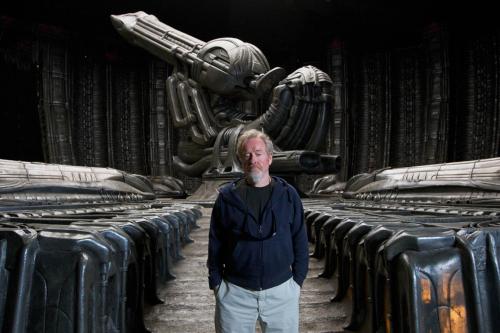
Ridley Scott on the Orrery/pilot chamber set. Destination: Paradise?
























